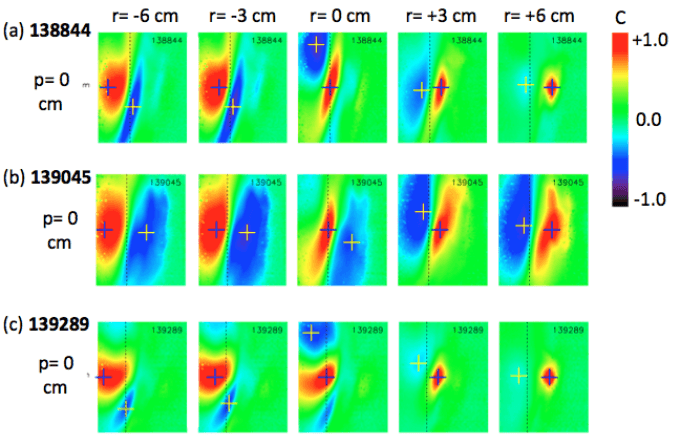Oct 16 2017
Fusion Researchers experience a major hurdle while understanding turbulence, the ripples and eddies causing the superhot plasma that fuels fusion reactions to leak particles and heat and prevent fusion from taking place.
Comprehending and then reducing turbulence will help in the development of fusion as a clean, safe and abundant source of energy for producing electricity from power plants all over the world.
 Correlation analysis of three plasma discharges on NSTX for each of five different radial locations near the plasma edge. The red regions marked with a blue cross have high positive correlation around the origin point, while the blue regions marked with a yellow cross have high negative correlation. Images courtesy of Stewart Zweben.
Correlation analysis of three plasma discharges on NSTX for each of five different radial locations near the plasma edge. The red regions marked with a blue cross have high positive correlation around the origin point, while the blue regions marked with a yellow cross have high negative correlation. Images courtesy of Stewart Zweben.
Scientists, at the U.S. Department of Energy’s (DOE) Princeton Plasma Physics Laboratory (PPPL), have assembled a large database of detailed measurements of the two dimensional (2D) structure of edge plasma turbulence made visible with the help of a diagnostic technique called gas puff imaging. The two dimensions, measured within a fusion device known as a tokamak, represent the vertical and radial structure of the turbulence.
Step toward complete understanding
This study is an incremental step toward a fuller understanding of turbulence. It could help us understand how turbulence functions as the main cause of leakage of plasma confinement.
Stewart Zweben, Physicist and Lead Author of the research published in the journal Physics of Plasmas
Fusion takes place naturally in space, blending the light elements in plasma in order to discharge the energy that powers the stars and sun. On Earth, Researchers produce fusion in facilities such as tokamaks, which are capable of controlling the hot plasma with magnetic fields. However, turbulence frequently makes heat leak from its magnetic confinement.
PPPL Scientists have presently researched beyond earlier published characterizations of turbulence and examined the data to focus on the 2D spatial correlations within the turbulence. This correlation offers clues to the origin of the turbulent behavior that leads to heat and particle leakage, and will indeed serve as an additional basis for testing computer simulations of turbulence against empirical evidence.
Analyzing 20 discharges of plasma
The paper analyzed 20 discharges of plasma selected as a representative sample of those produced in PPPL’s National Spherical Torus Experiment (NSTX) before to its latest upgrade.
A gas puff illuminated the turbulence next to the edge of the plasma, where turbulence is of particular interest, in each of these discharges. The puffs, considered to be a source of neutral atoms that have the potential to glow in response to density variations within a well-defined region, allowed Researchers to observe fluctuations in the density of the turbulence. The resulting light was recorded by a fast camera at the rate of 400,000 frames per second over an image frame size of 64 pixels wide by 80 pixels high.
Zweben and Co-authors carried out computational analysis of the data from the camera, establishing the correlations between various regions of the frames as the turbulent eddies moved via them.
We’re observing the patterns of the spatial structure. You can compare it to the structure of clouds drifting by. Some large clouds can be massed together or there can be a break with just plain sky.
Stewart Zweben, Physicist and Lead Author of the research published in the journal Physics of Plasmas
Detailed view of turbulence
The correlations provide an in depth view of the nature of plasma turbulence.
Simple things about turbulence like its size and time scale have long been known. These simulations take a deep dive into another level to look at how turbulence in one part of the plasma varies with respect to turbulence in another part.
Daren Stotler, PPPL Physicist and a Co-author of the paper
In the resulting graphics, a blue cross signifies the point of focus for a calculation; the yellow and red areas around the cross are regions in which the turbulence is developing similarly to the turbulence at the focal point. Farther away, Researchers discovered regions in which the turbulence is changing opposite to the variations at the focal point. These farther-away regions are displayed as shades of blue in the graphics, with the yellow cross signifying the point with the most negative correlation.
For instance, if the yellow and red images were a region of high density turbulence, the blue images showed low density. “The density increase must come from somewhere,” said Zweben. “Maybe from the blue regions.”
Moving forward, it is possible to use the knowledge of these correlations for predicting the behavior of turbulence in magnetically confined plasma. Success of the effort could boost the understanding of a central cause of the loss of heat from fusion reactions.
Filippo Scotti of the Lawrence Livermore National Laboratory and J. R. Myra of Lodestar Research Corporation also contributed to this study. The DOE Office of Science supported this work.
PPPL, on Princeton University's Forrestal Campus in Plainsboro, N.J., is keen on developing new knowledge about the physics of plasmas — charged, ultra-hot gases — and on creating practical solutions for the production of fusion energy. The University for the U.S. Department of Energy’s Office of Science, which is the largest single supporter of basic research in the physical sciences in the United States, manages the Laboratory, which is working towards addressing a few of the most pressing challenges that are currently available.